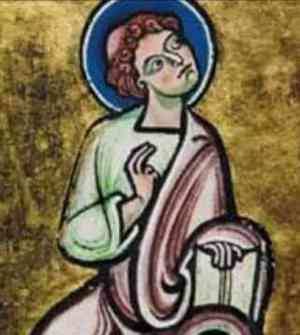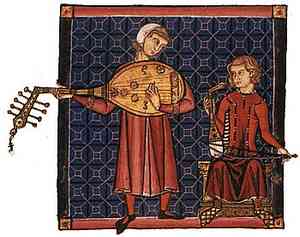


Leonin of Notre Dame
Source:
Geni
Born circa 1150 or 1155, likely in France, by the time Léonin (probably went by Léo) arrived to this planet the Second Crusade (1147-49) against Islam threatening regions of the Byzantine Empire, home of Eastern Orthodoxy, had only recently come and gone. The Norman (French) line of rule in England that had begun in 1066 with William the Conqueror and included such as Henry I and Matilda (Empress Maude) had come and gone as well by 1155, replaced in 1154 by the even more powerful French family that was the Plantagenets. Swedes had converted from Viking marauding to Roman Catholicism. A couple centuries earlier Eastern Catholicism had made its way from Constantinople to Novgorod in 866/867. By Leonin's time Eastern Orthodoxy in Russia had designs on Finland just as did the Roman Church in Sweden, which Fins called Ruotsi (Russia). Such the shifting greater theater of Léonin's world, not neglecting to mention the founding of Oxford University circa 1100 across the Channel in England, followed by the University of Paris about 1150.
Leonin is an apt example of early ars antiqua or, European music from the latter 12th through 13th century. Succeeding the ars antiqua would be the ars nova, when the Church began to recognize that not all music need be a Gregorian chant. As that didn't arrive for quite some time beyond Leonin, he applied himself to the Gregorian chant in the tradition of the Church. The Gregorian chant preceded Leonin by a couple of centuries. It has long been popularly credited to Pope Gregory I, who held the papal seat from 590 to 604. Developed itself out of the plainchant or plainsong that accompanied Christian rites from the begin, scholars believe the actual origins of the Gregorian chant to have been around 900, three centuries after Gregory I, emerging from a combination of the Carolingian and Gallican Roman chant with a stronger French than Italian heritage.
As for Léonin, though polyphony would be banned from the liturgy for a time in Rome in 1322 by Pope John XXII as not solemn enough for sacred music, in Paris it had long since been an early branch of study at the Notre Dame School of Polyphony where Leonin was employed since its inception. Léonin lived during the emergence of Gothic architecture. Below is a photo of the Cathedral de Notre Dame where Léonin worked during the early phases of its construction begun in 1163 during the reign of Louis VII. That was little like the cathedral completed circa 1300 represented below. Notre Dame had been built in association with the University of Paris.

Cathedral of Notre Dame (Notre-Dame de Reims)
Leonin was instrumental in the development of the motet (from "mot" that is French for "word") from out of the clausula (polyphonic song: two or more voices). The motet was a major step along the path of counterpoint first introduced in the latter 9th century in 'Musica Enchiriadis' ('Musical Handbook') by an anonymous French author. The motet was one of three forms of polyphony examined at Notre Dame, the others being the conductus and organum. Organum corresponds to polyphony or compositions of rhythm measured by meter. Leonin composed organum duplum, meaning polyphony two-part, which Leonin developed in elaboration to customary chant. Leonin's successor at Notre Dame, Perotin, composed organum triplum and organum quadruplum, that is, polyphonies three-part and four-part. Musical notation by Leonin is may be found in the folios his 'Magnus liber organi' ('The Great Book of Organum') serving as the repertoire of his Notre Dame School. Works below are stacked in alphabetical order:
'Alleluya Pascha nostrum' Leonin
Plain chant for choir w solo vocals in organum duplum (two-part polyphony)
Performed by the Early Music Consort of London directed by David Munrow
'Gaude Maria Virgo' Leonin
Plain chant for choir w solo vocals in organum duplum (two-part polyphony)
Performed by the Early Music Consort of London directed by David Munrow
'Haec Dies' ('This Is the Day') Leonin C 1175
The Schola Cantorum Londiniensis & Ambrosian Singers directed by Denis Stevens
'Messe du Jour de Noël' ('Mass for Christmas Day') Leonin
Ensemble Organum directed by Marcel Pérès
'Viderunt Omnes' Leonin
Gregorian chant based on Psalm 98 for Mass on Christmas Day
Performed by the Early Music Consort of London directed by David Munrow
As significant to medieval music as Notre Dame was, and the development of Leonin's sacred vocal polyphony, when it came to musical instruments for musicians of the secular sort, such as the accompaniment of troubadours, the lute reigned supreme. Developed in Mesopotamia about 3100 BC and introduced to Europe via the Arabian oud, the later Renaissance without the lute would have been like rock n roll without guitar. Below is a 12th century painting of a lute player in Spain.

12th Century Lute Player
Source:
Musicologie
Léonin's death is estimated in 1201 or 1210. Some think he is identical to the the poet, Leonius.
Sources & References for Leonin:
(History of Finland)VF History (notes)
Compositions (mentioned herein):
Alleluya Pascha nostrum: Fandom University of Arizona
Gaude Maria Virgo: Columbia University
Magnus liber organi (Great Book of Organum)
Messe du Jour de Noël: Jean Chrysostome
Viderunt omnes:
The Lute:
Britannica The Lute Society Met Museum Stephen Raskauskas Wikipedia
Musical Notation: Rhythmic Mode:
Notre-Dame School of Polyphony: Spinditty Wikipedia
Organum (plainchant w one or more independent singers):
Organum (unmeasured v measured): Columbia University
Organum Duplum (plainchant w two independent singers):
Oxford University:
Britannica Local Histories Oxford University Wikipedia
Polyphony:
Michael Delahoyde Pro Musician Hub Wikipedia
Recordings of Leonin (catalogs):
All Music Discogs Music Brainz Naxos RYM
Recordings of Leonin (select):
Leonin: Ecole Notre Dame (Ensemble Organum w Marcel Pérès 1985)
Music of the Gothic Era (Early Music Consort Of London w David Munrow 1976)
Sheet Music: Alleluya Pascha nostrum Haec dies
University of Paris: New World Encyclopedia Wikipedia
Bibliography:
Harvard Dictionary of Music (Second Edition / Belknap Press 1944/69/72)
Other Profiles:
Biography Bobb Edwards Encyclopedia Steven Estrella
Classical Main Menu Modern Recording
hmrproject (at) aol (dot) com